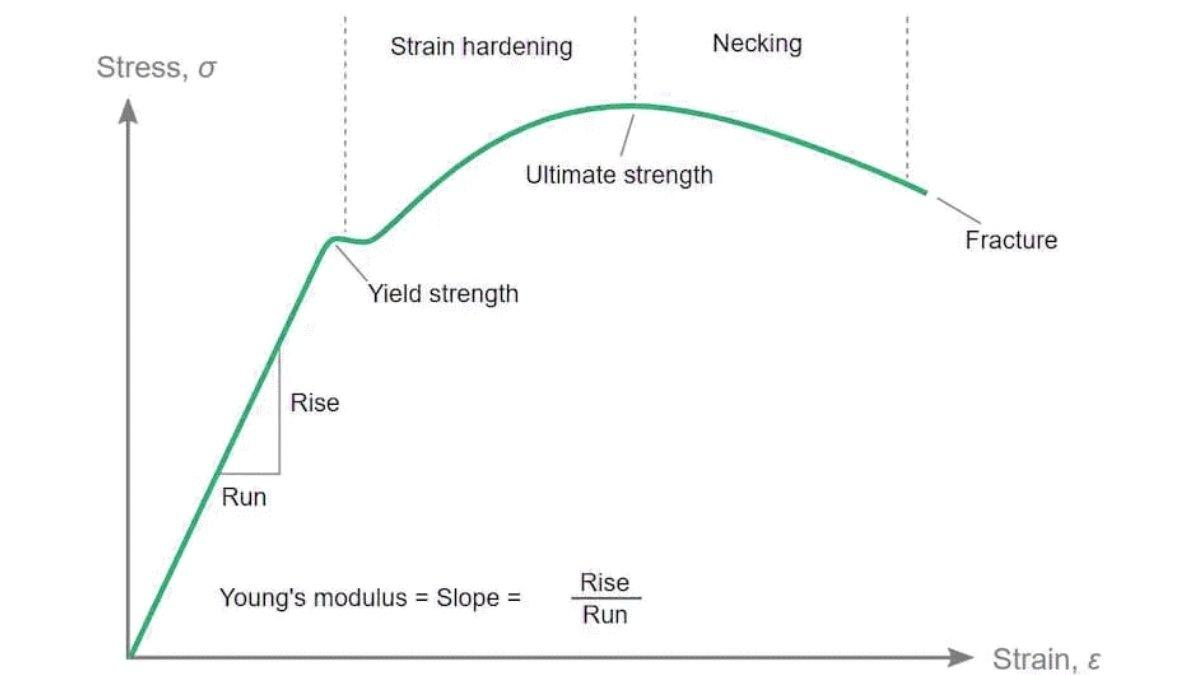Knowledge of the material’s strength, particularly metals, is quite imperative in most engineering disciplines. Among all the measurements, ultimate tensile strength (UTS) is referenced most frequently. The concept is utterly essential when evaluating material performance. UTS means a material’s ability to withstand tensile force without shredding. It becomes applicable in almost all products and accessories such as wires, ropes, and metallic frames. This article is all about Ultimate Tensile Strength (UTS).
Defining Ultimate Tensile Strength
UTS is a force used in stretching materials. It results in an increase in the size along the load axis. Tensile stress is stated as the force that is acting in a ratio to the area of the cross-section of the material.
𝐹: F applied to an elastic rod divided by the cross-sectional area
𝐴: An equal force A of the rod which is in its perpendicular direction.
Ductile materials can generally bear loads while, on the other hand, brittle materials might fail well before their capacity.
When a tensile force is applied, several tensile properties can be assessed:
- Elastic Modulus: The ratio of the change in stress to the corresponding change in strain. It is also known as the modulus of elasticity. EM is a measure of stress to strain during elastic deformation typically, measured from the stress-strain graph.
- Ultimate Tensile Stress (UTS): The maximum stress level to which any specified material can be tested at the required point. Normally measured when a tension test is taken. Thus, the maximum a material can be stretched is to the point of the known UTS; a crack can then form.
- Modulus of Resilience: The ratio was expressed as tensile stress over two times Young’s modulus of the material.
- Fracture Stress: Fracture stress, denoted as ‘σₓ’, is the maximum stress at the crack point just before failure occurs. As a rule, it’s calculated as the Stress = Applied Stress/Cross-Sectional area of the material. Generally, FS is measured in psi pound or tons per square inch.
UTS determines the maximum stress obtained in a tensile test during breakage. It defines how or in what way a particular material responds to various applications. Moreover, UTS is a fundamental property in determining material behavior performed under load.
UTS on a Stress-Strain Diagram
A stress-strain curve can be divided into four major regions:
Proportional Limit
The proportional limit is a region where the material behaves like a spring. The deformation occurring here is recoverable. The area shaded in the figure above is known as Hooke’s region according to Hooke’s law which defines the correlation between stress and strain.
Yield Limit
When the material reaches the proportional limit, then it lies in the yield limit zone. Here, permanent deformation takes place. In either case, the tensile force is unloaded or reversed; the material will not revert to its original size.
Strain Hardening Region
Higher tensile stress further leads the material to the strain-hardening region of the stress-strain curve. The particular section is notable because it changes the nature of the material’s crystals. The intended stress is enough to change the microstructure of the material. Also, it makes the material more resilient.
Necking Region
At a microscale, the material is at its strongest before it gets to the necking phase. However, once necking begins, it starts to weaken. Necking is marked by a local decrease in cross-section. Later on necking, the material gets closer to breakdown. At this stage, it offers less stress with more strain. Stress is defined as force per unit area and therefore, due to the limits of bone section area stress is high. The material degrades until the crack propagates through the element’s cross-section under consideration, and the element is rendered useless.
UTS Region on the Curve
The onset of the necking region from the strain-hardening region defines the UTS for the material. But this applies only when the material has reached its maximum strain hardening. Also, can support the highest safe load.
How can Ultimate Tensile Strength be Determined?
UTS is determined from tests performed in material testing laboratories, equipped with sophisticated testing equipment. Usually, stress is applied to a specimen in various ways and at various levels.
Testing Method
Before measuring TS, the engineer safely places the material in a tensile testing machine. Generally, these machines hold the specimen at two or more points of contact. It then places constant force on the specimen to pull it at a slower rate than that of the impact force utilized before.
The engineers supervising the test also observe and document several aspects of the material behavior on a stress-strain curve until the specimen fails or plastically deforms. These tests serve multiple purposes, including:
- Series of choosing the correct materials to be employed in developing the product.
- Forecasting of material behavior in practical uses.
- Monitoring of adherence level to the identified and agreed requirements and quality characteristics.
Testing new products
While conducting these tests, engineers seek specific information about the material’s properties, including:
- Maximum Load: The maximum load that the material can support in proportion or without cracking up.
- Ductility: The extent to which the specimen can be deformed before failure into small individual fragments.
- Bend: The ability of a material to bend without fracturing on one side, the other side, or both.
- Elongation %: The characteristic by which, the material providing a high elasticity becomes flexible when pressed.
The data gathered during testing helps the manufacturers decide on what material they should use in their processes. Tensile strength is measured in three key ways:
- Yield Strength: Measure of the maximum amount of stress a material can take before it is deformed irreversibly. The increase in yield point indicates the stress at which it cannot regain its original shape and form.
- Ultimate Strength: Defined as the maximum weight per unit volume, a material could bear in a tensioned state. As indicated earlier, the UTS can be defined as the load that an object can handle at any given time when divided by the area of the corresponding configuration of an object.
- Breaking Strength: BS, is the last stage in which the material can endure stress without cleavage.
Why Tensile Strength Understanding Is Important?
An understanding of the tensile strength of a material is crucial for application safety. Failure can occur when selecting materials with low tensile strength. In the design stage, engineers pay much attention to yield strength. Yield strength is defined as the stress limit at which satisficing and permanent deformation of parts takes place. As for ultimate tensile strength, it’s the strength of a material up to which the material can go on to fail. For instance, where the snow load is heavy the roof is bound to bend. Going beyond the tensile strength comes with the probability of having the structures brought down.
Tensile Strength vs. Yield Strength
Tensile strength and yield strength are two parameters in engineering scopes. Yield strength is usually employed in product design by engineers. Hence, to reduce risk, the load should be below this limit. The maximum load that is always placed on a material must never exceed its yield strength.
One must identify the amount of transverse section needed. It was found that the material properties and the geometry of the members determine the maximum load that can be applied. To optimize the solution, a safety factor is included to amplify the structural safety. This factor normally varies between 1.5 and 2. The second value is obtained by multiplying the maximum load by this factor. This accounts for unexpected loads and potential material defects.
Designing for ultimate tensile strength means possible deformation. The material could lose features that define its suitability for use. Certain tools are strain-hardened such as knives and spanners. This process improves their strength up to near ultimate tensile strength values before failure.
Ultimate Tensile Strength and Densities of Various Materials
The below-table shows several materials and their ultimate tensile strengths alongside their densities The following information is imperative to establish which materials should be used in engineering.
| Material | Ultimate Tensile Strength (MPa) | Ultimate Tensile Strength (psi) | Density (g/cm³) |
| Aluminum (2024-T3) | 570 MPa | 82,600 psi | 2.78 |
| Steel (Mild) | 400 MPa | 58,000 psi | 7.85 |
| Stainless Steel (304) | 580 MPa | 84,000 psi | 8.00 |
| Copper | 210 MPa | 30,500 psi | 8.96 |
| Brass | 500 MPa | 73,000 psi | 8.40 |
| Titanium (Grade 5) | 900 MPa | 130,000 psi | 4.43 |
| Cast Iron | 250 MPa | 36,300 psi | 6.89 |
| PVC (Polyvinyl Chloride) | 50 MPa | 7,250 psi | 1.40 |
| Concrete | 3-5 MPa | 435-725 psi | 2.40 |
| Nickel Alloys | 700 MPa | 101,500 psi | 8.90 |
Conclusion
UTS is quite fundamental in engineering. It aids in choosing materials for several uses. Knowledge of UTS helps in safety and performance guarantees. Metals usually have high values of tensile strength. Nonetheless, non-metallic components such as carbon fibers surpass them significantly. This shows that the choice of the material is crucial. Whether construction or using any other item, it is very essential to know UTS. Finally, only having adequate knowledge of UTS makes the item reliable and durable when used. Contact us for more information.





2 thoughts on “Ultimate Tensile Strength”